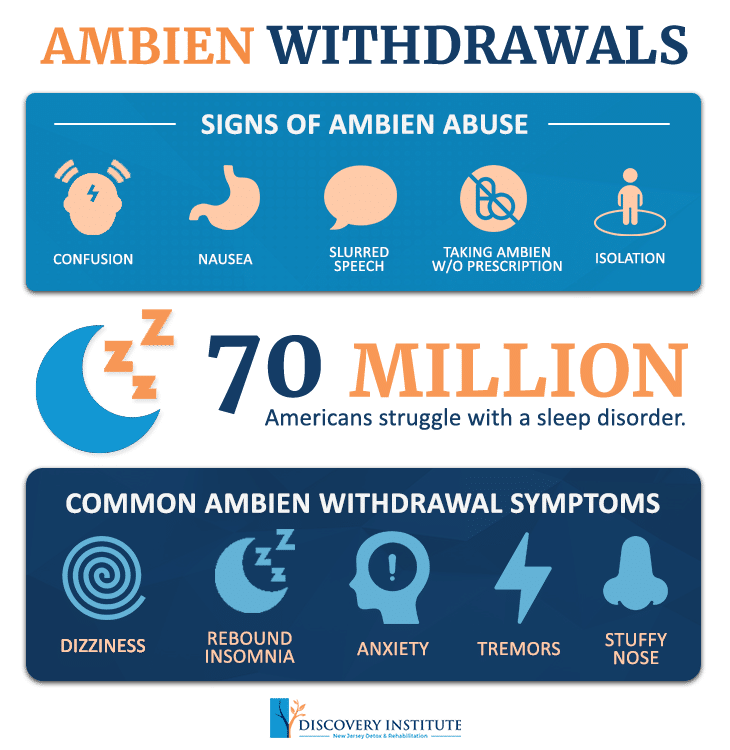It’s 4 AM, and you’ve flipped through the entire catalogs of all your favorite streaming services. Ambien withdrawal has set in after you recently quit cold turkey. It’s been two weeks since you’ve had an actual night’s rest, and insomnia has officially become your best friend.
According to the American Sleep Association, nearly 70 million Americans struggle with a sleep disorder. Insomnia is a common issue amongst adults, with a recommended 7 hours of sleep daily. This can have drastic effects on a person’s mental and physical health, which could influence other disorders and everyday tasks. Insomnia can last for months, which could require medication to improve sleep quality over time. Sleep is one of the vital functions of the body to make sure you process the day before and to restore individual systems.
Some factors that influence sleep disorders include:
- Caffeine, drug, and alcohol use
- High anxiety or stress
- Poor sleep conditions or environment
- Being an older woman
What Is Ambien, and What Is It Used For?
Zolpidem is a sedative that works on the GABA receptors in the brain by slowing the activity. Zolpidem can come in tablet or spray form, but absorption can be affected by what you eat. Ambien is the brand name of zolpidem, used to treat sleep disturbances over a short period. It is widely used and promoted as a less addictive alternative to benzodiazepines and other barbiturates. Ambien is noted for its almost euphoric, high effect on the user. It’s recommended that you take it an hour or two before bedtime to prevent further complications. Ambien is designed to improve sleep quality and duration with anticonvulsant qualities.
Ambien addiction is becoming increasingly reviewed, as users will combine this drug with other substances. The recommended dosage for Ambien is roughly 5mg or 10mg for adult men. The effects of Ambien wear off with time as your body adjusts to the sleep cycle and variations in brain activity. Ambien with alcohol can have unpredictable consequences as they are both depressants on the central nervous system. Ambien is noted for being taken with Valium, another sedative to boost the effects.
Addiction develops after a user has taken more than the prescribed amount. The users often don’t recognize they have an addiction due to the perception of the drug. Ambien prescriptions are given in short doses to prevent the body’s need for more of the drug. Since Ambien rewires the natural processes of the brain’s rhythm, it’s important to remember that it has the potential to develop abuse.
Signs of abuse might include:
- Taking higher doses than prescribed
- Taking Ambien without a prescription
- Slurred speech or distorted cognition
- Sleepwalking, eating, or driving
- Constant blackouts
- Impaired coordination
- Isolation
- Confusion
- Constant refills after an initial period
- Fatigue
- Nausea

What Are Some Side Effects of Ambien?
Excessive Sedation
The true danger of Ambien is when a user remains awake and attempts to function. Ambien is notable for having a “morning after” effect on the body, often remaining in the system for extended periods (up to 16 hours). Excessive sedation is an issue due to users increasing the dosage to permit potent effects. Due to its response in brain activity, individuals who use Ambien might complete tasks after taking the drug and have no memory of what occurred.
Sleepwalking
Ambien blackouts are a term to describe these behaviors, which are prompted by larger doses. Sleepwalking is one of the major factors of taking Ambien outside of recommended use. Individuals have been known to drive and cook while impaired, which presents a dangerous situation if an accident occurs. Imagine driving and conversing with a loved one under the influence, but having no memory of how it all happened when you come home to park.
Sleep-Eating
Sleep-eating is potentially dangerous as heavy doses can cause someone to prepare meals, leaving them exposed to fires and other accidents such as eating raw foods. Unexpected weight changes and imbalanced diets can occur during this period. Ambien poses a risk of sex without wakefulness, causing the person to even sleep with a stranger or friend. The transmission of STIs and herpes increases if the sex is not covered through precautions like condoms.
Depressive and Suicidal Thoughts
Another risk factor for Ambien is how it relates to depression and suicide. Ambien has been known to initiate depression and suicidal thoughts in users who did not have a previous history. The FDA warns that Ambien could have adverse effects on those with a history of depression. Co-occurring disorders can make Ambien use more complicated, as the user might be using the drug to combat mental health issues but could worsen. High doses of Ambien can pose health risks in those with or without a history of mental health.
Hallucinations have been reported in those who use high doses of Ambien with other substances such as alcohol and opioids.
Can I Overdose on Ambien?
Ambien overdose can occur with high doses. Anything from 400-600mg of Ambien can lead to overdose, but the approximate lethal amount of Ambien is equated to 2,000mg, but it depends on how it’s taken. Symptoms of Ambien overdose might include severe drowsiness, irrational thoughts, and abnormal breathing. In the event of an Ambien overdose, the patient’s stomach would need to be pumped. Flumazenil would be administered to combat the sedation of the drug, which could lead to a coma.
What Are Some Common Ambien Withdrawal Symptoms?
Ambien withdrawal symptoms can occur shortly after use has stopped, typically 48 hours. The withdrawals can last up to 1 to 2 weeks, depending on the amount taken and length of time. The bulk of the withdrawals typically appears within three days after use has stopped. The body can develop a tolerance over two weeks, which is essential to determine a window of recovery.
Some common Ambien withdrawal symptoms might include:
- Rebound insomnia
- Mood swings and irritability
- Dizziness
- Stuffy nose
- Anxiety
- Tremors
- Headaches
What Does the Ambien Withdrawal Timeline Look Like?
Those who are addicted to Ambien will take 10-20mg daily, outside of the recommended dosage of 5mg. Within the first 48 hours of heavy use, one can expect Ambien withdrawals to begin. At the 3-5 day mark, the storm of the worst symptoms manifest. A person might experience nausea, amnesia, and irritability. Panic attacks, tremors, and rebound insomnia are common symptoms during this time. By the two-week mark, the person begins to return to their normal state.
Ambien withdrawal symptoms can vary with the person and their body types. Women are noted to be more susceptible to the adverse effects of Ambien. On average, one can expect the symptoms to be similar to benzodiazepines, lasting up to 2 weeks. If these symptoms last longer than two weeks, post-acute withdrawal symptoms have kicked in — which can last up to 2 years with varying severity.
How Do You Treat Ambien Withdrawal?
Ambien withdrawal should be treated under medical supervision. Tapering off Ambien is a wise decision to prevent the tolerance from building up. The patient’s body needs to adjust to a life without Ambien to prevent panic attacks and overactivity. Detoxification might be necessary, but the withdrawal symptoms are non-lethal. Less than 1% of withdrawal symptoms from Ambien have resulted in seizures. These cases were highlighted by users who decided to quit abruptly without supervision.
Medication
Medication might be provided to handle the uncomfortable withdrawal symptoms. A medication called quetiapine has been used to treat the symptoms of Ambien withdrawal. Prescription medication treatment programs are becoming more accessible throughout the country. Valium is another medication used to alleviate symptoms through its long-acting release in the body. It’s noted that Valium is prescribed for extreme Ambien addiction and should not be used as a replacement drug.
Although relapse is possible, it’s important to note that medical detox is only a resource for recovery. If an outpatient treatment program is necessary, it could be beneficial to find what underlying causes formed the addiction. Maintaining the flexibility of home life and job is critical to the recovery of those with mild to moderate Ambien addiction. Cognitive-behavioral therapy has shown promising results to understand and modify compulsive behaviors. The stigma of addiction to prescription medication might influence someone to neglect treatment. The fight against addiction is meant to be fought with support.
For individuals stopping Ambien after long-term use, it’s crucial to understand that your sleep cycle is adaptable. Reducing stress in your life would be recommended to give your mind a break before you head to sleep. Reprogramming your sleep cycle through routine would establish a practice of proper sleep health. Caffeine and other addictive substances alter the chemistry in the brain, often promoting wakefulness or disturbance in sleep. It’s important to reduce or cut these out of your lifestyle to ensure a proper slate. By enabling a distraction-free environment, it could be helpful to your overall sleep quality.
Embrace Care Through Discovery Institute
Ambien withdrawal can be a challenging period for those in need of recovery. Discovery Institute encourages the path towards healing by optimizing therapies and care. Addiction treatment should be widely available and specific to each patient. If you or a loved one are grappling with addiction, please contact us today. We’re here to listen and support.
Dr. Joseph Ranieri D.O. earned his BS in Pharmacy at Temple University School of Pharmacy in 1981 and His Doctorate Degree in Osteopathic Medicine at the Philadelphia College of Osteopathic Medicine in 1991. He is Board Certified by the American Board of Family Medicine and a Diplomate of the American Board of Preventive Medicine Addiction Certification. Dr. Ranieri has lectured extensively to physicians, nurses, counselors and laypeople about the Disease of Addiction throughout New Jersey and Pennsylvania since 2012.



